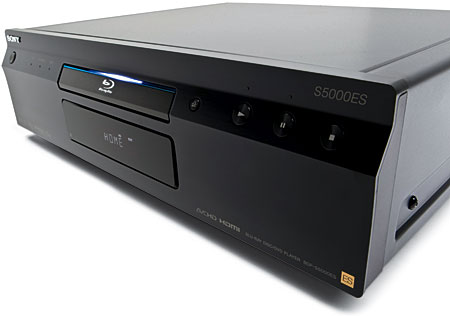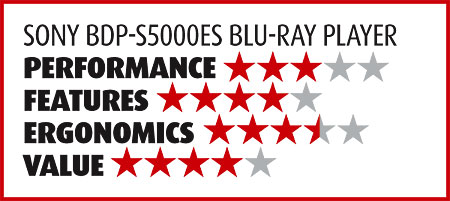Sony BDP-S5000ES Blu-ray Player Page 2
When I get a product in to review, I’m very conscious of its performance in comparison to the rest of the market. Most consumers don’t have the opportunity to sample a large range of components across various price points. They may not realize what they can and can’t get for the same amount of money. With flagship products, I set my critical bar even higher.

I was disappointed by the BDP-S5000ES’ video-processing performance with our standard tests. High-end models from Denon and Pioneer Elite incorporate state-of-the-art processing, and even low-priced designs from Panasonic and other manufacturers offer excellent performance and pass our HD video-processing tests. Hopefully, this is something that Sony will address with future ES models. The video performance here is comparable to standard Sony Blu-ray players that are available for less.
In Use
You can have the greatest player on the market, but if it’s cumbersome to use, it will wear you down. Thankfully, the BDP-S5000ES excels in this department. Sony incorporates its Xross Media Bar (XMB) user interface, which was made popular by the PlayStation Portable and PS3.
The BDP-S5000ES’s implementation is identical to the BDP-S350’s, including icons for different media types and a Setup icon. I would have liked to see Sony take the level of refinement here up to the PS3’s level, though. With the PS3, you can change the XMB’s theme and backdrop. The PS3’s XMB interface also shows you a thumbnail image of the Blu-ray Disc you’ve loaded. This data is stored on the Blu-ray Disc itself, and quite a few studios support this function. Unfortunately, the BDP-S5000ES only shows a generic disc icon with no thumbnail.
 Disc loading times and navigation have also been a contentious issue with Blu-ray players. It almost seems like the more expensive the player is, the slower it gets. The BDP-S5000ES is a breath of fresh air for its price point, but it still has a lot of room for improvement. Load times were in line with the BDP-S350 and in the middle of the pack of recently tested players when it came to overall speed. Newer Java-intensive titles were on the sluggish side with load times, but once the disc loaded, the player showed good overall responsiveness. Sony has implemented a quick turn-on feature that puts the player in a pseudo-standby mode when it’s powered off. This eats up a bit more power in idle, but it improved power-on times quite a bit. I just wish Sony had made the BDP-S5000ES’s load times more similar to the PS3’s, since there are now a couple of standalone Blu-ray players at this level—or even faster.
Disc loading times and navigation have also been a contentious issue with Blu-ray players. It almost seems like the more expensive the player is, the slower it gets. The BDP-S5000ES is a breath of fresh air for its price point, but it still has a lot of room for improvement. Load times were in line with the BDP-S350 and in the middle of the pack of recently tested players when it came to overall speed. Newer Java-intensive titles were on the sluggish side with load times, but once the disc loaded, the player showed good overall responsiveness. Sony has implemented a quick turn-on feature that puts the player in a pseudo-standby mode when it’s powered off. This eats up a bit more power in idle, but it improved power-on times quite a bit. I just wish Sony had made the BDP-S5000ES’s load times more similar to the PS3’s, since there are now a couple of standalone Blu-ray players at this level—or even faster.
I really liked the remote that comes with this player. The button layout is very intuitive, and the backlighting made it a breeze to find the more important keys in the dark. You can also turn off the light by hitting the Light key again. Most remotes that light up stay on a little longer than I prefer, so this is a nice feature.
The BDP-S5000ES would make a great standalone CD player, and its analog multichannel output does a commendable job with Blu-ray playback if you’re going that route, including bass management with time alignment. But in this HDMI-oriented world, how many people still use analog connections? The main benefit to using analog outputs would be the high-quality digital-to-analog converters that Sony employs in this design. But most AVRs and surround processors have limited analog preamp capabilities. With an analog input, many of them require analog-to-digital conversion for any post processing, followed by digital-to-analog conversion at the output. This essentially negates the benefits of the Sony’s high-end analog output stage for many users.
Sony (and other manufacturers) may want to consider incorporating popular signal-processing features into their players, with future flagship designs that boast reference analog audio performance. This way, consumers could apply post-processing tools (like Audyssey room correction, Dolby Pro Logic IIx, or THX’s suite of refinements) to the high-resolution audio without the need for another analog-to-digital conversion in an AVR or surround processor with multi-channel analog inputs. The DSP chips that are required to do this have come down tremendously in price, so the cost of adding a feature like this would be small. With the huge price disparity between flagship models and standard Blu-ray players, manufacturers should look at innovative solutions like these.
Conclusion
I’m a bit on the fence when it comes to Sony’s new flagship design. The build quality is impeccable, and the player does a superb job with DVD and Blu-ray playback at 1080p/24. With full interactivity and advanced audio covered, this is a player that will serve the consumer’s basic needs for a long time. And the step-up CD playback performance over analog is commendable. However, at this price point, I think consumers should expect more cutting-edge features like high-end HD video processing and wireless connectivity.






























































